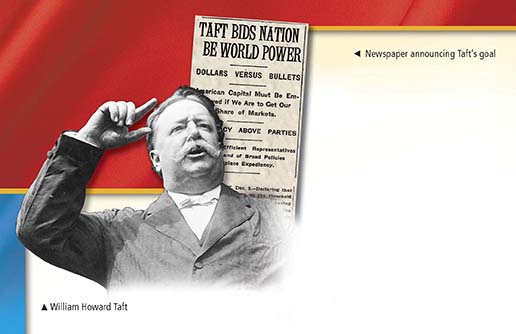SECTION 4: The United States and Latin America

WITNESS HISTORY  AUDIO
AUDIO
Dollars for Bullets
Like President Roosevelt, President William Howard Taft stressed the need to assert American power around the world. Taft’s “dollar diplomacy” aimed to expand American investments abroad:
“The diplomacy of the present administration … has been characterized as substituting dollars for bullets…. It is [a policy] frankly directed to the increase of American trade upon the axiomatic principle that the government of the United States shall extend all proper support to every legitimate and beneficial American enterprise abroad.”
—President William Howard Taft, 1912
Objectives
- Examine what happened to Puerto Rico and Cuba after the Spanish-American War.
- Analyze the effects of Roosevelt’s “big stick” diplomacy.
- Compare Wilson’s “moral diplomacy” with the foreign policies of his predecessors.
Terms and People
- Foraker Act
- Platt Amendment
- “big stick” diplomacy
- Panama Canal
- Roosevelt Corollary
- “dollar diplomacy”
- “moral diplomacy”
- Francisco “Pancho” Villa
NoteTaking
Reading Skill: Identify Supporting Details Complete a table like the one below to note how the U.S. dealt with Puerto Rico and Cuba.
| Puerto Rico | Cuba |
|---|---|
|
|
Why It Matters As the United States tentatively asserted its interests in East Asia, Americans called for a more aggressive role in Latin America. American entrepreneurs and government leaders viewed the region as the nation’s backyard and as a sphere of influence from which other great powers should be excluded. American influence in Latin America brought obvious benefits to the United States, but it also contributed to anti-American hostility and instability in the region. Section Focus Question: What actions did the United States take to achieve its goals in Latin America?
U.S. Policy in Puerto Rico and Cuba
America’s victory over Spain liberated the Puerto Rican and Cuban people from Spanish rule. But victory left the fates of these islands unresolved. Would Puerto Rico and Cuba become independent nations? Or would they become colonies of the United States? As questions lingered in the aftermath of war, the United States assumed control in Puerto Rico and Cuba.
Civil Government in Puerto Rico
As the smoke from the Spanish-American War cleared, Puerto Rico remained under direct U.S. military rule. In 1900, Congress passed the Foraker Act, which established a civil government in Puerto Rico. The act authorized the President of the United States to appoint a governor and part of the Puerto Rican legislature. Puerto Ricans could fill the rest of the legislature in a general election.




